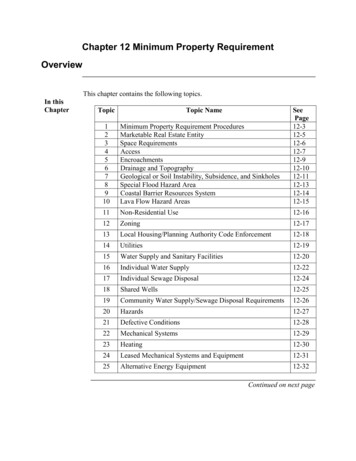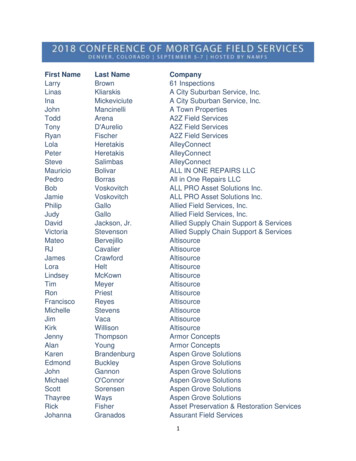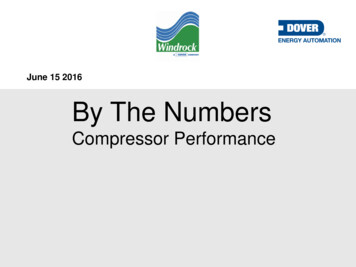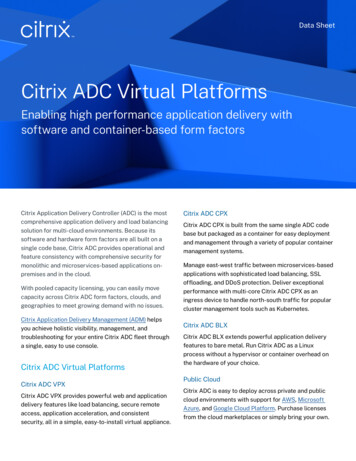
Transcription
Chapter 12 Minimum Property RequirementOverviewIn thisChapterThis chapter contains the following topics.TopicTopic Name12345678910Minimum Property Requirement ProceduresMarketable Real Estate EntitySpace RequirementsAccessEncroachmentsDrainage and TopographyGeological or Soil Instability, Subsidence, and SinkholesSpecial Flood Hazard AreaCoastal Barrier Resources SystemLava Flow Hazard 1412-1511Non-Residential Use12-1612Zoning12-1713Local Housing/Planning Authority Code Enforcement12-1814Utilities12-1915Water Supply and Sanitary Facilities12-2016Individual Water Supply12-2217Individual Sewage Disposal12-2418Shared Wells12-2519Community Water Supply/Sewage Disposal Requirements12-2620Hazards12-2721Defective Conditions12-2822Mechanical Systems12-2923Heating12-3024Leased Mechanical Systems and Equipment12-3125Alternative Energy Equipment12-32Continued on next page
VA Pamphlet 26-7, RevisedChapter 12: Minimum Property Requirements1. Minimum Property Requirement Procedures, continueda. MPRs,continued12-2TopicTopic Name26272829303132333435363738Roof CoveringAtticsCrawl SpaceBasementsSwimming PoolsBurglar BarsLead-Based PaintWood Destroying Insects/Fungus/Dry RotRadon GasPotential Environmental ProblemStationary Storage TanksMineral, Oil and Gas Reservations or LeasesHigh Voltage Electric Transmission 4012-4212-4312-4412-4512-46394041424344High Pressure Gas and Liquid Petroleum PipelinesProperties Near AirportsManufactured Home Classified as Real EstateModular HomesEnergy Conservation and SustainabilityRequests for Waiver of MPR Repairs12-4712-4812-4912-5012-5112-52
VA Pamphlet 26-7, RevisedChapter 12: Minimum Property Requirements1. Minimum Property Requirement ProceduresChange DateOctober 18, 2019 This chapter has been revised in its entirety.a. MPRsVA has established Minimum Property Requirements (MPRs) to protect theinterests of Veterans, lenders, servicers, and VA. Properties must meet theserequirements prior to guaranty of the loan by VA.b. Appraisal is While VA-assigned fee appraisers must note any readily apparent repairs thatNot a Homeare needed, it is important to distinguish the differences between a real estateInspectionappraisal and a home inspection report. The fee appraiser will not performoperational checks of mechanical systems or appliances. The fee appraiserestimates the value of the property to ensure that it is sufficient for the amountof the proposed loan.c. Safe, Sound, MPRs help ensure that the property is safe, structurally sound, and sanitary.SanitaryThe scope of MPRs also includes issues related to the property’s location andlegal considerations.d. AppraisalSubject toRepairs tomeet MPRsThe appraiser will prepare origination appraisals “subject to” the completionof any MPR repairs that appear to be needed and include the contributoryvalue of the completed repairs in the estimated market value. Liquidationappraisals are prepared “as-is” (see Chapter 11, Topic 20 of this Handbook).e. Recommend Appraisers must not prepare appraisals subject to inspections. The appraiserRepairs, Notmust recommend repairs, not inspections, for any conditions that do not appearInspectionsto meet MPRs.f. CosmeticItemsThe appraiser should not recommend repairs of cosmetic items, itemsinvolving minor deferred maintenance or normal wear and tear, or items thatare inconsequential in relation to the overall condition of the property. Whileminor repairs should not be recommended, the appraiser should consider theseitems in the overall condition rating when estimating the market value of theproperty.Continued on next page12-3
VA Pamphlet 26-7, RevisedChapter 12: Minimum Property Requirements1. Minimum Property Requirement Procedures, continuedg. DetachedDetached sheds or other improvments on the site may be included in value ifthe improvement meets VA’s MPRs. If the improvement does not meet MPRsit must be excluded from value. If the improvement presents a health or safetyhazard, the appraisal must be completed subject to the removal of theimprovement.h. HomeAfter an origination appraisal is completed, the Notice of Value (NOV) that isissued to the Veteran includes a recommendation that the Veteran may wish toobtain a home inspection (see Chapter 13, Appendix A of this Handbook).i. LocalRequirementsInformation about MPRs concerning properties in specific locations are listedby state athttp://www.benefits.va.gov/HOMELOANS/appraiser cv local req.asp.j. SAHAdditional MPRs apply to Specially Adapted Housing (SAH) program cases.The Regional Loan Center (RLC) of jurisdiction should be contacted forassistance with SAH questions.ImprovementsInspectionRecommended12-4
VA Pamphlet 26-7, RevisedChapter 12: Minimum Property Requirements2. Marketable Real Estate EntityChange DateOctober 18, 2019 This chapter has been revised in its entirety.a. Single RealEstate EntityThe property must be a single, readily marketable, real estate entity.b. MultipleParcelsMore than one parcel or lot may be included as long as all of the property iscontiguous and legally marketable. VA does not set a limit on the number ofacres that the property may have. If the property being appraised includesmore than one parcel, the appraisal must be prepared subject to placing all ofthe parcels on one deed.c. Road orWaterwayDividing thePropertyIf a property is divided by a road or waterway, the appraiser must determinethe effect on the utility of the property to ensure that the property is a readilymarketable, real estate entity.12-5
VA Pamphlet 26-7, RevisedChapter 12: Minimum Property Requirements3. Space RequirementsChange DateMarch 28, 2019 This chapter has been revised in its entirety.a. SpaceRequirementsEach living unit must have sufficient space for:b. NonStandardConstructionNon-standard house styles which may be unique in a market area, for example,log houses, earth sheltered houses, dome houses, and houses with lower thannormal ceiling heights, must meet any local building codes. The appraisermust consider the marketability of the home in the appraisal.12-6 living,sleeping,cooking and dining, andsanitary facilities.
VA Pamphlet 26-7, RevisedChapter 12: Minimum Property Requirements4. AccessChange DateMarch 28, 2019 This chapter has been revised in its entirety.a. StreetAccessEach property must be provided with a safe and adequate pedestrian orvehicular access from a public or private street with an all-weather surface.b. PrivateRoadRequirementsPrivate roads must be:c.MaintenanceAgreementSignaturesIf a maintenance agreement does not exist, every effort should be made toobtain the agreement of all owners of properties on the private road to sharethe cost of maintaining the road.d. RLCApprovalRequired ifthe Veteran isAcceptingAdditionalResponsibilityIn the absence of an agreement signed by all owners, particularly those ofproperties located between the subject property and the public road, anagreement by a Veteran to accept responsibility for a disproportionate share ofthe road must be reasonable in regards to the distance from the subjectproperty to the public road. The RLC of jurisdiction must be contacted in orderto approve the agreement. VA will not accept an agreement in which theVeteran accepts sole responsibility for maintaining an unreasonable distanceof the private road as this could create a burden for the Veteran as well asfuture property owners.e. PrivateStreet in PUDorCondominiumIf private street maintenance is covered in the organizational documents for aplanned unit development (PUD) or condominium, or by state law, the NOVmay be issued without a requirement for further documentation.f. EasementsMust Run withthe LandEach living unit must be accessible without passing through any other livingunit or trespassing on adjoining properties. Any easements required must runwith the land. protected by a permanent easement, andmaintained by a homeowners association or joint maintenanceagreement.Continued on next page12-7
VA Pamphlet 26-7, RevisedChapter 12: Minimum Property Requirements4. Access, continuedg. BackyardAccessAccess to the backyard must be provided without passing through any otherliving unit. For a row-type dwelling, the access may be by means of an alley,easement, orpassing through the subject dwelling.h. ExteriorWall AccessAdequate space to perform maintenance of the exterior walls must be presentbetween buildings.i. PropertyConstructedAdjacent toAnotherProperty LineA building constructed on or next to a property line must be separated from theadjoining building by a wall extending the full height of the building from thefoundation to the ridge of the roof.12-8
VA Pamphlet 26-7, RevisedChapter 12: Minimum Property Requirements5. EncroachmentsChange DateMarch 28, 2019 This chapter has been revised in its entirety.a.EncroachmentsThe appraiser must report any apparent encroachments of the subject’sdwelling, garage, or other improvements onto an adjacent property, right-ofway, utility easement, or building restriction line and any apparentencroachments of a neighboring dwelling, garage, or other improvements ontothe subject property.b. PromptNotificationThe appraiser must notify the lender of the encroachment promptly to provideas much time as possible to resolve the issue.12-9
VA Pamphlet 26-7, RevisedChapter 12: Minimum Property Requirements6. Drainage and TopographyChange DateMarch 28, 2019 This chapter has been revised in its entirety.a. GradingThe site must be graded so that it b.TopographicConditions12-10provides positive, rapid drainage away from the perimeter walls of thedwelling, andprevents ponding of water on the site.The appraiser must report any danger due to topographic conditions, such asmudslides from adjoining properties, falling rocks, or avalanches.
VA Pamphlet 26-7, RevisedChapter 12: Minimum Property Requirements7. Geological or Soil Instability, Subsidence, and SinkholesChange DateOctober 18, 2019 This chapter has been revised in its entirety.a. SoilConditionsThe appraiser must report any readily observable soil conditions of the site,and other physical features that affect the value of the site. The appraisershould also consider any published reports regarding the instability of the soiland surface support of the land concerning the subject and nearby properties.The appraiser must consider any effect on the estimated market value of theproperty.b. SubsidenceSubsidence may be encountered where homes are constructed on uncontrolledfill or unsuitable soil, in locations near mining activity or extraction ofsubsurface minerals (to include fracking), or where the subsoil or subsurface isunstable and subject to slippage or expansion. Signs of subsidence mayinclude cracks in the terrain, sinkholes, foundation damage or settlementproblems.c. DangerousSubsidence orSinkholesThe appraiser must report any probable or imminent danger of subsidence orsinkholes. Depending on the extent of the problem, it could be considered ahazard (see Topic 20 of this Chapter) which would make the propertyineligible. The appraiser must notify the lender promptly when a hazardouscondition is found.d. Repairs byContractorIf a settlement problem that does not have the severity of a hazard is apparent,the appraisal must be prepared “subject to repair” by a licensed contractor (forexample, step-cracks in an exterior wall, or cracked flooring with significantvertical displacement).e. HairlineCracksMinor hairline cracks due to expansion or normal settlement that are commonin the market area do not typically require repair.Continued on next page12-11
VA Pamphlet 26-7, RevisedChapter 12: Minimum Property Requirements7. Geological or Soil Instability, Subsidence, and Sinkholes,continuedf. New orProposedPropertyFor new or proposed construction properties, in areas that have a history ofgeological or soil instability, the builder must submit either: 12-12a certification that to the best of the builder’s knowledge and belief,any geological or soil-related hazard has been compensated for in theengineering design of the improvements and no portion of theconstruction will rest on fill, orevidence from a qualified geologist or engineer that the subject siteeither does not present unusual geological soils-related hazards or suchhazards have been compensated for in the engineering design of theimprovements. (Qualified geologists are state licensed or are amember of a national or state organization which requiresresponsibility, experience, education and demonstrated ability in thefield of engineering geology.)
VA Pamphlet 26-7, RevisedChapter 12: Minimum Property Requirements8. Special Flood Hazard AreaChange DateOctober 18, 2019 This chapter has been revised in its entirety.a. FloodInsuranceProperties located in a FEMA Special Flood Hazard Area (SFHA) must becovered by a flood insurance policy. Properties located in a SFHA are noteligible if flood insurance is not available.b. RegularFloodingBased on the appraiser’s knowledge of the market area, properties that aresubject to regular flooding are not eligible, whether or not the area has beendesignated an SFHA.c. Verificationof Flood ZoneWhile appraisers must provide flood zone information on the appraisal report,flood zone maps do not typically indicate the location of specific properties.Lenders are responsible for verifying the flood zone information.d. FloodZonesSFHAs are usually designated Zones A, AO, AH, A1-A30, AE, A99, AR,AR/AE, AR/AO, AR/A1-A30, AR/A, V, VE, and V1-V30. Flood insurance isnot required in Zones B, C, X, and D.e. ExcludingNonResidentialImprovementsAt the Veteran’s request, non-residential improvements such as detachedgarages and small sheds may be excluded from the flood insurance policy ifthey are also excluded from the appraised value. The cost of flood insurancewith and without coverage for the detached building should be compared asexcluding a detached building may not be worthwhile.f. PrivateFloodInsuranceVeterans may elect to obtain private flood insurance instead of obtaining floodinsurance through the National Flood Insurance Program.12-13
VA Pamphlet 26-7, RevisedChapter 12: Minimum Property Requirements9. Coastal Barrier Resources SystemChange DateMarch 28, 2019 This chapter has been revised in its entirety.a. EligibilityProperties located in Coastal Barrier Resources System (CBRS) areas are noteligible for an appraisal.b. AppraiserAppraisers who perform appraisals for VA near the Atlantic Ocean, the GreatLakes, the Gulf of Mexico, or the Caribbean Sea must be familiar with anyCBRS areas. If the appraiser finds that a property on which an appraisal hasbeen ordered is located in a CBRS area, the appraiser must stop work andpromptly notify the lender.Responsibilities12-14
VA Pamphlet 26-7, RevisedChapter 12: Minimum Property Requirements10. Lava Flow Hazard ZonesChange DateMarch 28, 2019 This chapter has been revised in its entirety.a. AppraiserResponsibilityLava Flow Hazard Zones are designated by the United States GeologicalSurvey. Appraisers who perform appraisals for VA in affected areas must befamiliar with these zones.b. PropertyEligibilityProperties in Zones 1 and 2 are not eligible for appraisal. If the appraiserfinds that a property on which an appraisal has been ordered is located inZone 1 or 2, the appraiser must stop work and promptly notify the lender.c. MarketValue to beConsideredIf the property is in a Lava Flow Hazard Zone other than Zone 1 or 2, theappraiser must report the zone information in the appraisal and analyze theeffect on market value.12-15
VA Pamphlet 26-7, RevisedChapter 12: Minimum Property Requirements11. Non-Residential UseChange DateMarch 28, 2019 This chapter has been revised in its entirety.a. EligibilityConsiderationsA property that has both a residential and business use may be eligible for loanguaranty if: b. No Value toBusiness orCommercialProperty12-16the property is primarily for residential use,the non-residential use does not impair the residential character,the property contains no more than one business unit, andthe property is legally permitted and conforms to current zoning, or is alegal, non-conforming use that is accepted by the local authority.No value may be given to the business operations or commercial fixtures inthe appraisal.
VA Pamphlet 26-7, RevisedChapter 12: Minimum Property Requirements12. ZoningChange DateMarch 28, 2019 This chapter has been revised in its entirety.a. ZoningComplianceThe property must comply with all applicable zoning ordinances.b. Legal, NonConformingUseIf the property does not comply with current zoning ordinances, but isaccepted by the local authority, the appraiser must describe the property as“Legal Non-Conforming” and comment on the property’s marketability andany adverse effect this classification may have on value. The appraiser muststate whether or not the dwelling may be legally rebuilt if destroyed.12-17
VA Pamphlet 26-7, RevisedChapter 12: Minimum Property Requirements13. Local Housing/Planning Authority Code EnforcementChange DateMarch 28, 2019 This chapter has been revised in its entirety.a. LocalAuthorityRequirementsIf the property is located in an area where specific local housing/planningauthority code requirements are enforced in conjunction with the sale ofhomes, the appraiser must describe the requirements in the appraisal report.b. RepairsRequired by aLocalAuthorityIf the appraiser is aware of any repairs that will be required due to local codeenforcement, for example, the removal of unpermitted improvements, theappraiser must prepare the appraisal subject to these repairs.12-18
VA Pamphlet 26-7, RevisedChapter 12: Minimum Property Requirements14. UtilitiesChange DateMarch 28, 2019 This chapter has been revised in its entirety.a. ElectricityEach living unit must have electricity for lighting and for necessaryequipment.b. AppraiserNotConductingOperationalChecksSince the appraiser does not perform any operational checks of mechanicalsystems or appliances, the utilities are not required to be turned on when theappraiser visits the property.c. ElectricalWiresAny visible frayed or exposed electrical wires must be repaired.d. Utilities forLiving UnitsUtility services must be independent for each living unit, except e. Access forMaintenanceand Repairunits in a two to four-unit property may share water, sewer, gas,or electricity as long as there are separate service shut-offs foreach unit, andunits under separate ownership may share connections from themain to the building line when those connections are protected byan easement and a maintenance agreement acceptable to VA.Individual utilities serving one living unit shall not pass over, under, orthrough another living unit unless there is a legal provision for a permanentright of access for maintenance and repair of the utilities without trespass onadjoining properties.12-19
VA Pamphlet 26-7, RevisedChapter 12: Minimum Property Requirements15. Water Supply and Sanitary FacilitiesChange DateMarch 28, 2019 This chapter has been revised in its entirety.a. Water andSewerThe property must have: a continuous supply of safe and potable water for drinking, bathing,showering and sanitary uses,hot water,sanitary facilities, anda safe method of sewage disposal.b. SafeDrinkingWaterGiven the importance of safe drinking water, appraisers must ensure thataccurate water supply information is reported in the appraisal and the StaffAppraisal Reviewer (SAR) must condition the NOV appropriately. If theappraiser is aware of any issues regarding the water supply, the appraiser mustcomment in the appraisal.c. MarketValueConsiderationsAppraisers must comment and adjust for any market reaction discovered as aresult of water contamination, as well as any environmental stigma.d. Filtration of Proper mitigation of lead contaminated water must include a central filteringWatersystem which filters all water that could serve the property’s occupants. Whenpublic water must be filtered, the requirements for individual water filteringunder Topic 17, Subsection d of this Chapter including a Veteran’sacknowledgement, must be applied. Information about water filtration isavailable at tinued on next page12-20
VA Pamphlet 26-7, RevisedChapter 12: Minimum Property Requirements15. Water Supply and Sanitary Facilities, continuede. IndividualWater SupplyIf the property has an individual water supply see Topic 17 of this Chapter foradditional requirements.f. IndividualSewer SupplyIf the property has an individual sewer supply see Topic 18 of this Chapter foradditional requirements.g. ConnectionMandated bya LocalAuthorityIf public water or sewer is available and the local authority mandatesconnection, the appraiser must prepare the appraisal “subject to” connection.12-21
VA Pamphlet 26-7, RevisedChapter 12: Minimum Property Requirements16. Individual Water SupplyChange DateMarch 28, 2019 This chapter has been revised in its entirety.a. HealthAuthorityRequirementsWater quality for an individual water supply must meet the requirements of thehealth authority having jurisdiction. If the local authority does not havespecific requirements, the guidelines established by the EnvironmentalProtection Agency (EPA) will apply. Additional information is available atthe following websites: ater-well-programs-your-state te/wells/testing.html.b. Third PartyTestingAll testing must be performed by a disinterested third party. This includescollecting and transporting the water sample from the water supply source.The sample may be collected and tested by the local health authority, acommercial testing laboratory, a licensed sanitary engineer, or other party thatis acceptable to the local health authority. At no time will the Veteran or otherinterested party collect and/or transport the sample.c. ConditionsRequiring aVeteran’sSignedStatementThe appraiser must comment in the appraisal and the Veteran mustacknowledge awareness in writing when the water to the property is:d. WaterFiltrationSystemIf the property has a water filtration system, the Veteran must acknowledge inwriting that the water must be continuously treated as required by the localhealth authority to be considered safe for human consumption and for this tobe effective, the system must be inspected and maintained to include filterreplacements per the manufacturers’ recommendations. supplied by dug wells, cisterns, or holding tanks used in conjunctionwith water purchased and hauled to the site,provided with a mechanical chlorinator,provided through springs, lakes, rivers, sand-point or artesian wells, orsupplied with a rainwater catchment system.Continued on next page12-22
VA Pamphlet 26-7, RevisedChapter 12: Minimum Property Requirements16. Individual Water Supply, continuede. DistanceRequirementsThe appraiser must be familiar with the minimum distance requirementsbetween private wells and sources of pollution. The appraiser is not required tosketch or note distances between the well, property lines, septic tanks, drainfields, or building structures.f. TestingValidityPeriodWater quality test results are valid for 90 days from the date certified by thelocal health authority unless the local authority indicates otherwise.g. ConnectionMandated bya LocalAuthorityIf public water is available and the local authority mandates connection,connection is required (see Topic 16 of this Chapter).12-23
VA Pamphlet 26-7, RevisedChapter 12: Minimum Property Requirements17. Individual Sewage DisposalChange DateMarch 28, 2019 This chapter has been revised in its entirety.a. IndividualSewageDisposalAn individual sewage disposal system must adequately dispose of all domesticwastes in a sanitary manner which will not create a nuisance, or in any wayendanger the public health.b. Pit PriviesIndividual pit privies are acceptable where such facilities are customary andinstalled in accordance with the recommendations of the local health authority.c. HealthAuthorityApprovalOn proposed construction cases, or new or existing construction cases wherethe appraiser notes a problem, or if the area is known to have soil percolationproblems, health authority approval of the individual sewage disposal systemis required.d. ConnectionMandated bya LocalAuthorityIf public sewer is available and the local authority mandates connection,connection is required (see Topic 16 of this Chapter).12-24
VA Pamphlet 26-7, RevisedChapter 12: Minimum Property Requirements18. Shared WellsChange DateMarch 28, 2019 This chapter has been revised in its entirety.a. SharedWellRequirementsA shared well refers to a well that serves two or more properties. The sharedwell must be: capable of providing a continuing supply of safe and potable water toeach property simultaneously, so that each dwelling will be assured asufficient quantity for all domestic purposes,protected by a permanent easement, which allows for maintenance andrepair, andmaintained under a well-sharing agreement containing provisions forthe cost of repairs that is binding on the signatory parties andsuccessors in title and has been recorded in public records.b. AppraiserResponsibilityThe appraiser must report that that the property is served by a shared well andnote any readily apparent deficiencies.c. LenderResponsibilityThe lender must obtain the shared well agreement and review the agreement todetermine eligibility.d. WaterQualityThe water quality must meet the requirements for individual wells described inTopic 17 of this Chapter.12-25
VA Pamphlet 26-7, RevisedChapter 12: Minimum Property Requirements19. Community Water Supply/Sewage Disposal RequirementsChange DateMarch 28, 2019 This chapter has been revised in its entirety.a. CommunityWater/Sewerto be Noted inan AppraisalA community water/sewage system refers to a central system that is owned,operated, and maintained by a private corporation or a nonprofit propertyowners’ association. The appraiser must note that the property is on acommunity water/sewage system in the appraisal report.b. SufficientWater SupplyThe water supply must be sufficient in size for the project. Water quality mustbe approved by the local or state health authority.c. AdequateSize SewageSystemThe sewage system must be adequate in size and properly operated andmaintained to prevent it from becoming a menace to public health.d. Local/StateAuthorityApprovalThe lender must obtain evidence of approval of the facilities by the local orstate health authority.e. Trust DeedA trust deed is required if the local or state authority that approved the systemdoes not: f. Trust Deedfor PrivateSystem12-26enforce compliance with its requirements,fix rates, andprovide for prompt relief in case of deficient operation, service, orexorbitant rates.If a trust deed is required for a privately-owned system, it should be similar tothe trust deed found in HUD Handbook 4075.12.
VA Pamphlet 26-7, RevisedChapter 12: Minimum Property Requirements20. HazardsChange DateMarch 28, 2019 This chapter has been revised in its entirety.a. HazardsThe property must be free of hazards which may: b. PromptNotification ofthe Lenderadversely affect the health and safety of the occupants,adversely affect the structural soundness of the dwelling and otherimprovements to the property, orimpair the customary use and enjoyment of the property by theoccupants.The appraiser must notify the lender promptly when a hazard is identified sothat the eligibility of the property may be addressed and, depending on thenature of the hazard, to provide as much time as possible to resolve thesituation.12-27
VA Pamphlet 26-7, RevisedChapter 12: Minimum Property Requirements21. Defective ConditionsChange DateOctober 18, 2019 This chapter has been revised in its entirety.a. DefinitionConditions which impair the safety, sanitation, or structural soundness of thedwelling will cause the property to be unacceptable until the defects orconditions have been remedied and the probability of further damageeliminated. The integrity of the envelope of the structure must not becompromised.b. Appraisals“Subject to”Repair ofDefectiveConditionsAppraisals must be prepared “subject to” the repair of any defective conditionswith the contributory value of the completed repair included in value.c. ExamplesExamples of defective conditions include: 12-28defective construction,poor workmanship,evidence of continuing settlement,excessive dampness,leakage,decay, andtermites.
VA Pamphlet 26-7, RevisedChapter 12: Minimum Property Requirements22. Mechanical SystemsChange DateMarch 28, 2019 This chapter has been revised in its entirety.a.RequirementsMechanical systems must be:b. AppraiserResponsibilityWhile the appraiser is not required to test the operation of any mechanicalsystems, the appraiser should recommend the completion of any repairs thatare readily apparent. safe to operate, andprotected from destructive elements.12-29
VA Pamphlet 26-7, RevisedChapter 12: Minimum Property Requirements23. HeatingChange DateMarch 28, 2019 This chapter has been revised in its entirety.a.RequirementHeating must be permanently installed and maintain a temperature of at least50 degrees Fahrenheit in areas with plumbing.b. Non-Vented If the dwelling will have a permanently installed, non-electric, non-ventedHeaterfireplace or other non-vented space heater: the NOV must be conditioned to require the Veteran’s writtenacknowledgement that the dwelling contains anon-vented fireplace or space heater which has not been inspectedby VA, anda licensed heating/air conditioning contractor must certify in writingthat the non-vented appliance is equipped with a
log houses, earth sheltered houses, dome houses, and houses with lower than normal ceiling heights, must meet any local building codes. The appraiser must consider the marketability of the home in the appraisal. VA Pamphlet 26-7, Revised Chapter 12:











